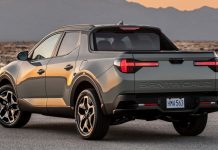Here’s the latest reader question, along with my reply!
Mark asks: How about 360 hp, 500 ft.-lb. of torque from a 2.7 liter gas engine that gets 35+ mpg? Have you seen or heard about this?
My reply: The current (2019) F-150 does offer a 2.7 liter “EcoBoost” V6 with twin turbos, but it only makes 325 horsepower and carries an EPA mileage rating of 19 city/24 highway (4WD versions). I have driven this truck and can report it averages high teens unless driven with a very light foot.
I hugely doubt a 360 hp version would be capable of matching the EPA’s rosy numbers – and forget “35+” MPG.
A diesel engine might be able to get close to 30 . . . on the highway. But with a gas engine, this is very improbable.
You can’t have your cake (power/capability) and eat it, too (high mileage). Usually, one or the other thing has to be compromised.
A 1500 Series truck like the F-150 is expected to be capable of things such as pulling/carrying a heavy load, which is at odds with high gas mileage.
Mileage can be increased – without compromising capability – if you’re willing to accept higher cost for the vehicle itself. For example, aluminum rather than steel bodies; small/highly turbocharged engines; transmissions with multiple overdrive gears; direct-injection/cylinder deactivation/auto-stop/start… and so on.
But now you’ve spent more money on the vehicle than you’ve saved on gas.
Aye, there’s the rub!
. . .
Got a question about cars – or anything else? Click on the “ask Eric” link and send ’em in!
If you like what you’ve found here please consider supporting EPautos.
We depend on you to keep the wheels turning!
Our donate button is here.
If you prefer not to use PayPal, our mailing address is:
EPautos
721 Hummingbird Lane SE
Copper Hill, VA 24079
PS: Get an EPautos magnet (pictured below) in return for a $20 or more one-time donation or a $5 or more monthly recurring donation. (Please be sure to tell us you want a sticker – and also, provide an address, so we know where to mail the thing!)
My latest eBook is also available for your favorite price – free! Click here. 












Sure, they could do it right now. Build it with a magnesium frame, suspension, motor block, transmission cases & wheels, then use carbon-fiber for the all the body parts including the bed. It would probably blow off the road in a strong wind, but the govt. meteorologists are going to fix that problem, too!
Interesting. An engine design that has been around for over 100 years.
If it is anything like as presented, could be a very good option.
https://www.motortrend.com/news/at-least-one-automaker-plans-to-produce-an-opposed-piston-engine/
Unfortunately, “Meeting regulations further out into the future can be done by applying current technologies like 48-volt electrification to the Achates engine.”
Revealing the truth that no matter what efficiency is achieved, it will never be enough for TPTB and they will move the goalposts yet again…..
Fairbanks-Morse used opposed-piston engines in their diesel-electric locomotives. I think they were used for marine propulsion, as well. There’s no reason, that I know of, that they can’t be scaled down and used in cars and trucks.
All good points, but, you missed the message. 35 MPG F-150 is on the horizon.
Achates Power, a California-based engine developer, and Aramco Services, the transportation-focused U.S. arm of Saudi Arabian Oil Co., or Aramco, are jointly testing the truck, a Ford F-150 outfitted with the Achates engine.
The goal is to demonstrate that the truck’s unique 2.7-liter, opposed-piston, compression-ignition gasoline engine indeed delivers the 37-mpg fuel efficiency, 270 horsepower, 429 pound-feet of torque and 50 percent emissions reduction that Achates claims for it.